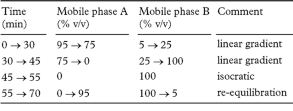Cefaclor Capsules
Action and use
Cephalosporin antibacterial.
Definition
Cefaclor Capsules contain Cefaclor.
Content of anhydrous cefaclor, C15H14ClN3O4S
95.0 to 105.0% of the stated amount.
Identification
Tests
Dissolution
Comply with the requirements for Monographs of the British Pharmacopoeia in the dissolution test for tablets and capsules, Appendix XII B1.
Calculate the total content of anhydrous cefaclor, C15H14ClN3O4S, in the medium from the absorbances obtained and using the declared content of C15H14ClN3O4S in cefaclor BPCRS.
Related substances
Carry out the method for liquid chromatography, Appendix III D, using the following solutions in a 0.27% w/v solution of sodium dihydrogen orthophosphate which has been adjusted to pH 2.5, if necessary, with orthophosphoric acid (solution A). The solutions should be freshly prepared.
Equilibrate the column with a mixture of 5 volumes of mobile phase B and 95 volumes of mobile phase A for at least 15 minutes. Inject the solutions and carry out the following gradient elution.
The test is not valid unless, in the chromatogram obtained with solution (3), the resolution factor between the peaks due to cefaclor and delta-3-cefaclor is at least 2.0. If necessary, adjust the proportion of acetonitrile in the mobile phase.
In the chromatogram obtained with solution (1):
the area of any secondary peak is not greater than half the area of the principal peak in the chromatogram obtained with solution (2) (0.5%);
the sum of the areas of any such peaks is not greater than twice the area of the principal peak in the chromatogram obtained with solution (2) (2%).
Disregard any peak with an area less than 0.1 times the area of the principal peak in the chromatogram obtained with solution (2) (0.1%).
Assay
Carry out the method for liquid chromatography, Appendix III D, using the following solutions.
Dissolve 1 g of sodium pentanesulfonate in a mixture of 780 mL of water and 10 mL of triethylamine, adjust the pH to 2.5 using orthophosphoric acid, add 220 mL of methanol and mix.
The Assay is not valid unless, in the chromatogram obtained with solution (3), the resolution factor between the peaks due to cefaclor and delta-3-cefaclor is at least 2.5 and the symmetry factor of the peak due to cefaclor is at most 1.5.
Calculate the content of C15H14ClN3O4S in the capsules from the chromatograms obtained and using the declared content of C15H14ClN3O4S in cefaclor BPCRS.
Storage
Cefaclor Capsules should be stored at a temperature not exceeding 30°.
Labelling
The quantity of active ingredient is stated in terms of the equivalent amount of anhydrous cefaclor.
